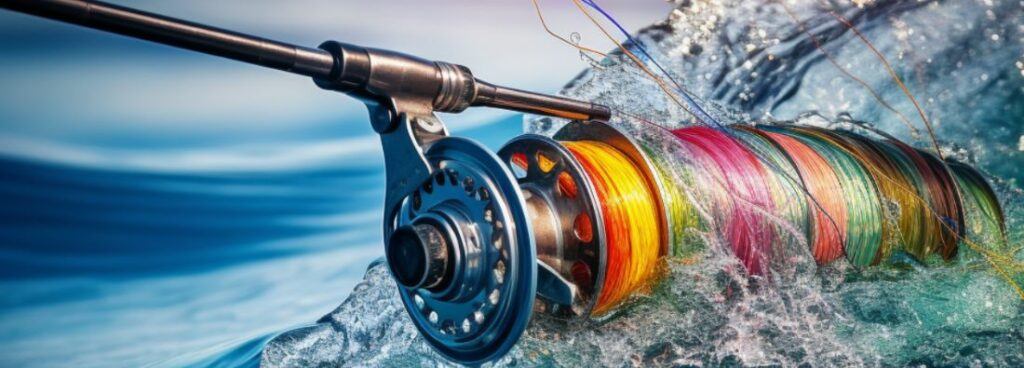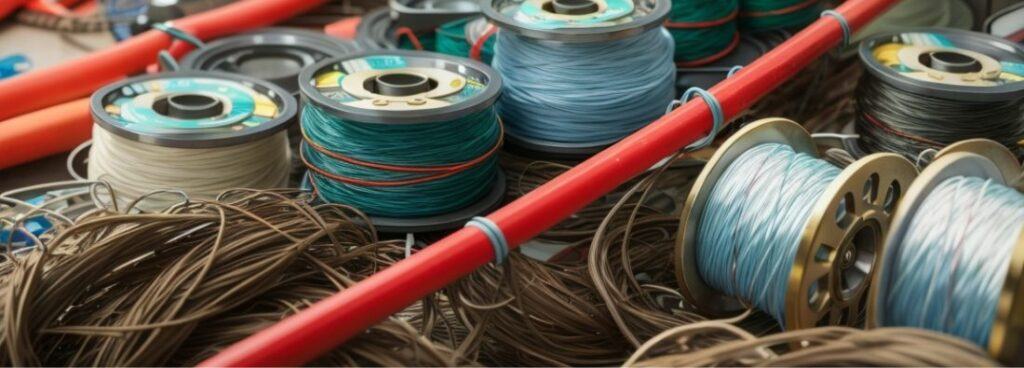Stories Worth Reeling In...
Last Updated on October 31, 2023
Hey there, fishing enthusiasts! Selecting the right gear is a game-changer in our world, and the fishing braid we choose holds a spot at the top of that list. “Factors to consider when selecting a fishing braid” sounds pretty straightforward, but it’s a decision that carries a lot of weight in the outcome of our fishing adventures.
Choosing a fishing braid isn’t just about finding the strongest one or the one that looks the most durable. It’s about finding a braid that matches our fishing style, the environment, and the species we’re aiming to catch. It’s a combination of science and, let’s admit, a bit of personal preference.
In this guide, we’re going to unravel the details, considerations, and insider tips that will help you make an informed decision about selecting a fishing braid that won’t let you down. So, let’s dive in and explore the factors that will lead you to your ideal fishing braid!
Table of Contents
When choosing a braided fishing line, consider the fishing environment and your specific needs. Look at factors such as diameter, strength, and material to ensure it suits your fishing style and target species. Also, consider the line’s visibility, color, and abrasion resistance to match the water conditions you plan to fish in.
Alright, let’s get into the nitty-gritty—the material and construction of the fishing braid. These two aspects are like the backbone of your fishing line. They determine how tough, sensitive, and durable your line is going to be out there in the water.
Most braided lines are made from high-tech synthetic materials like Dyneema or Spectra. These materials are the unsung heroes, making the braid strong, durable, and ready to take on the challenges of the underwater world.
It’s like choosing the fabric of a superhero’s costume; it’s got to withstand all sorts of battles!

The way a braid is woven or constructed plays a huge role in its performance. A tightly woven braid, for instance, is more round and resists digging into the reel under pressure. It’s like having a well-knit sweater that holds up against the cold—it’s all about staying strong under pressure!
Understanding the material and construction of your braid is essential. It’s like knowing your car’s engine; it helps you drive it better.
So, choose a braid that matches your fishing style and the battles you intend to face in your aquatic adventures!
Now, let’s talk about two crucial things that you shouldn’t overlook when choosing a fishing braid: diameter and strength. These factors are like the muscle and bone of your line, dictating how much it can handle and how subtly it can perform.
The diameter of your fishing braid is more important than you might think. A thinner line means you can pack more of it onto your reel, and it’ll be less visible to those wary fish. It’s like wearing a slim-fit suit; it just looks sharper and operates smoother in the water.
Breaking strength is like the braid’s personal best at the weightlifting bench. It tells you how much weight the line can handle before snapping. But remember, match the strength to the fish you’re targeting; you wouldn’t use a heavyweight boxer to catch a featherweight, right?
Choosing the right diameter and strength is about finding a balance that suits your fishing style and the species you’re after.
It’s like picking the right gear for a hike; you want it to be tough enough for the journey but not overkill for the trail.
Alright, let’s dive into something that adds a bit of flair to our fishing game… color! But it’s not just about looking good; the color of your braid can actually be a game-changer in how successful your fishing day turns out.
Different water conditions call for different colors. In clearer waters, you might want to go for a more subdued, natural color that won’t spook the fish.
It’s like wearing camouflage in the woods; you want to blend in, not stand out like a sore thumb.

Fish, especially the smart old big ones, can be pretty picky about what they go after. If your line is too visible, it might just turn them off, like wearing sneakers to a black-tie event.
Some anglers swear by bright lines to help them see the line movement better, but remember, if you can see it easily, so can the fish.
Choosing the right color is about matching your environment and making the fish comfortable enough to take a bite.
Keep it stylish but sensible, and you’ll be reeling them in in no time.
Let’s get into another crucial aspect: the length and capacity of the braid. It’s like choosing the right amount of rope for rock climbing; you don’t want to find yourself coming up short!
First off, how long should your braid be? Well, it depends on what you’re after and where you’re fishing. If you’re hitting the deep seas, you’ll need a longer line to reach those mysterious depths where the big ones lurk.
But for a casual day at the lake, you won’t need as much.
Your reel is like the heart of your fishing setup, and it’s got its limits. Load it with too much line, and you’ll be dealing with a mess, like trying to stuff a sleeping bag into a sock.
Make sure your reel and line are a good match, so they work together, not against each other.
Choosing the right length and capacity is about balance. It’s making sure you’ve got enough line to get the job done without overloading your gear.
Keep it balanced, and you’ll be set for a smooth day on the water.
Alright, let’s talk toughness—abrasion resistance, to be exact. It’s like the armor your line wears in battle against the rough and tough underwater world.

Fishing lines can be pretty rough. They rub against rocks, scrape through vegetation, and endure the powerful strikes and runs of hefty fish.
A braided line with solid abrasion resistance is like a knight in shining armor, taking all the hits and standing strong.
You Might want to know What is the Thinnest, Strongest Fishing Braid
Different fishing spots come with their own challenges. In some places, your line might face a battleground of sharp rocks and tough obstacles, while in others, it might be more about dealing with the brute force of powerful fish.
Choosing a braid that can handle the specific challenges of where you’re fishing is key to coming out victorious.
So, when selecting a fishing braid, consider its ability to withstand the rough stuff.
A tough, abrasion-resistant line will keep you in the game longer, fighting fish without worrying about breaking off.
Alright, folks, let’s get knotty! Knot strength is like the handshake of the fishing world.
A strong, solid knot is a promise that your setup won’t bail on you when things get real with a big fish.
A strong knot is like having a trustworthy buddy on the other end of the line. It holds everything together, ensuring that your lure or hook stays connected.
Weak knots? They’re like flaky friends—they might bail on you right when you need them the most.
Braided lines can be a bit slick, making them a slippery customer when it comes to tying knots. But don’t sweat it; some knots play nicer with braided lines.
The Palomar knot or the Uni knot, for example, are like the best buds of braided lines, holding tight and staying loyal through thick and thin.
So, when you’re gearing up, make sure your knots are tied with precision and care.
A well-tied knot is one less thing to worry about when you’re wrestling with a water beast on the other end of the line.
Let’s dive into another crucial aspect – sensitivity and stretch. When it comes to feeling what’s happening underwater, these two factors are your best pals.
Braided lines are like the superheroes of sensitivity in the fishing line universe.
They transmit the tiniest nibbles, bumps, and thuds from the other end, making sure you don’t miss a beat. It’s like having a direct hotline to the underwater action, keeping you in the loop when a fish so much as glances at your bait.
Now, the low stretch of braided lines is a big win. It means that the line won’t absorb much shock, keeping you connected directly to the fish’s movements.
It’s like having a more responsive car; you feel the road better, understanding every move, every intention of your finned adversary.
So, in the battle of bites, a braided line gives you the upper hand, allowing for quicker and more confident hook sets.
It’s all about feeling connected, staying in touch with the underwater drama, and making your move with precision and confidence.
Navigating through the ocean of fishing braids, price and brand reputation are like your trusty compass and North Star. They guide your journey, ensuring you sail towards value and reliability.
We all want the best bang for our buck, right? But don’t let a low price tag lure you into a false sense of bargain. Sometimes, saving a few bucks upfront can lead to a sea of troubles later.
Look for a braid that offers a good balance of quality and cost. It’s about investing in a line that won’t leave you stranded mid-adventure.

Brand reputation is like the folklore of fishing. Stories of triumph, tales of reliability, and legends of performance navigate you toward the best choices.
Go for brands that have weathered the storms and sailed through the tests of time and tide.
A reputable brand is like a seasoned captain, guiding you through your fishing journey with expertise and reliability.
When choosing your fishing braid, it’s like preparing for a journey. You wouldn’t head into a snowstorm dressed in shorts and a T-shirt, right?
Similarly, consider the environment where you’ll be casting your line.
Different waters call for different approaches. Saltwater, freshwater, or venturing into various terrains, each has its own unique challenges.
Tailor your braid selection to suit the environment. It’s about being in tune with nature, adapting, and making choices that flow with the water’s rhythm.
Customization is key. In saltwater, you’re dealing with bigger, more aggressive fish and corrosive water. You might want a braid that’s tough as nails and can withstand the ocean’s raw power.
For freshwater, it might be more about finesse, precision, and subtlety.
Adapt your gear to meet the demands of the environment, ensuring that you’re always in sync with the surroundings.
Avoid using braided fishing lines when you need more line stretch, like when using some crankbaits. It might not be the best choice for clear water conditions due to its high visibility. Also, consider using a different line if you’re targeting fish with softer mouths to reduce the chance of hook pull-out.
Navigating through the vast ocean of fishing braids, we’ve embarked on a journey exploring various shores—from the material and construction to the environmental considerations.
The factors to consider when selecting a fishing braid are as diverse as the fish in the sea, each playing a crucial role in determining the success of your angling adventures.
We’ve unraveled the mysteries of diameter and strength, delved into the colorful world of visibility, and weighed the significance of length and capacity.
Our voyage also took us through the rugged terrains of abrasion resistance, the intricate art of knots, and the subtle nuances of sensitivity and stretch.
Remember, choosing a fishing braid is more than just a purchase; it’s a strategic decision. It’s about aligning your arsenal with the rhythms of the water, the habits of the fish, and the whispers of the wind.
So, arm yourself with knowledge, be attuned to the environment, and may your fishing lines always be tight and your catches plentiful!
Tight lines!